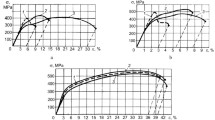Conclusions
-
1.
In reaction-bound silicon nitride specimens quenched in water after having been heated to 400–480°C, thermal shock causes weakening by a factor of six to seven. With lower heating temperature weakening is not encountered. The test results of specimens without weakening and with considerable weakening overlap in the range of furnace temperatures 400–480°C.
-
2.
Calculations of the state of stress of a rod by the finite element method showed that the first cracks may appear 0.1 sec after the specimens were submerged in water.
-
3.
The coefficient of variation of specimens that are substantially weakened after being cooled from 400–500°C increases by 35–50%. When the specimens are heated to 700–900°C, the coefficient of variation is equal to the initial value because of a large number of thermal cracks. This was also confirmed by an analysis of the fractures of specimens.
Similar content being viewed by others
Literature Cited
D. P. H. Hasselman, “Thermal stress resistance parameters for brittle refractory ceramics: a compendium,” Am. Ceram. Soc. Bull.,49, No. 12, 1033–1037 (1970).
G. Ziegler and R. Leucht, “Thermoschockuntersuchungen an Siliciumnitrid,” Ber. Dtsch. Keram. Ges.,55, No. 2, 105–109 (1978).
Yung-Tsen Chien and Yung-Chao Ko, “High temperature fracture energy and thermal stress resistance of bauxite brick,” Am. Ceram. Soc. Bull.,64, No. 7, 1017–1020 (1985).
G. A. Gogotsi and A. N. Negovskii, “Application of methods of nondestructive inspection for evaluating thermal damage to ceramics under conditions of nonsteady thermal effects,” Probl. Prochn., No. 1, 43–47 (1985).
G. A. Gogotsi, Some Results of the Study of the Mechanical Properties of Structural Ceramics Applied to Engine Parts [in Russian], Preprint, AN USSR, Institute of Strength Problems, Kiev (1983).
S. S. Kutateladze, Heat Transfer in Condensation and Boiling [in Russian], Mashgiz, Moscow-Leningrad (1952).
A. A. Shmykov, Heat Engineers' Handbook [in Russian], Mashinostroenie, Moscow (1961).
Additional information
Kaunas. Obninsk. Translated from Problemy Prochnosti, No. 11, pp. 57–60, November, 1988.
Rights and permissions
About this article
Cite this article
Kazakyavichyus, K.A., Narbutene, D.V., Chasovskoi, E.N. et al. Thermal shock resistance of silicon nitride ceramics. Strength Mater 20, 1477–1480 (1988). https://doi.org/10.1007/BF01530150
Received:
Issue Date:
DOI: https://doi.org/10.1007/BF01530150




